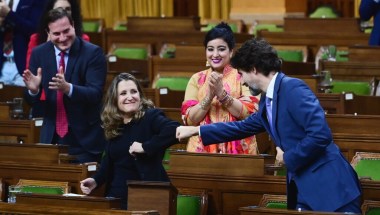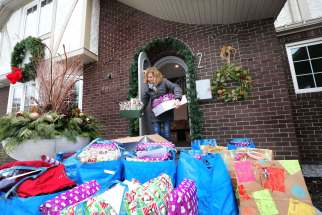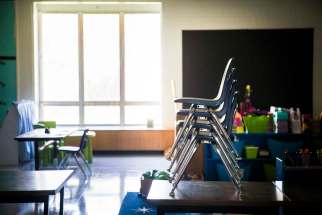Post-Christmas remote learning way to protect public: education minister Decision affects grades 7 to 12 for two weeks
Read this article for free:
or
Already have an account? Log in here »
To continue reading, please subscribe:
Monthly Digital Subscription
$0 for the first 4 weeks*
- Enjoy unlimited reading on winnipegfreepress.com
- Read the E-Edition, our digital replica newspaper
- Access News Break, our award-winning app
- Play interactive puzzles
*No charge for 4 weeks then price increases to the regular rate of $19.00 plus GST every four weeks. Offer available to new and qualified returning subscribers only. Cancel any time.
Monthly Digital Subscription
$4.75/week*
- Enjoy unlimited reading on winnipegfreepress.com
- Read the E-Edition, our digital replica newspaper
- Access News Break, our award-winning app
- Play interactive puzzles
*Billed as $19 plus GST every four weeks. Cancel any time.
To continue reading, please subscribe:
Add Free Press access to your Brandon Sun subscription for only an additional
$1 for the first 4 weeks*
*Your next subscription payment will increase by $1.00 and you will be charged $16.99 plus GST for four weeks. After four weeks, your payment will increase to $23.99 plus GST every four weeks.
Read unlimited articles for free today:
or
Already have an account? Log in here »
Hey there, time traveller!
This article was published 02/12/2020 (1838 days ago), so information in it may no longer be current.
Grade 7-12 students will temporarily move to remote learning in the new year, as part of the province’s plan to ensure COVID-19 cases don’t spike after the holidays — should people defy public health advice and get together.
Starting Jan. 4, following the scheduled winter break, the province’s oldest learners will study at home.

That option will also be available to kindergarten to Grade 6 students — at their parent’s discretion — for the two-week period that runs until Jan. 15.
Education Minister Kelvin Goertzen and Dana Rudy, deputy minister, announced what they call a preventative measure on Wednesday.
Goertzen said the decision to create a buffer period after the break takes into consideration the transition planning time required and public health advice, given the province has recorded an uptick in COVID-19 cases after holidays, including Thanksgiving.
“(Public health officials) support this plan. They think it’s both prudent and balanced in terms of ensuring that students, by and large, have the availability of in-class learning, except for a brief disruption, primarily for those in the older age groups,” he told reporters.
“(Public health officials) support this plan. They think it’s both prudent and balanced in terms of ensuring that students, by and large, have the availability of in-class learning, except for a brief disruption, primarily for those in the older age groups.”
– Education Minister Kelvin Goertzen
During that period, classroom instruction will be available for the youngest students, as well as for any Grade 7 to 12 student who has special needs that require accommodation at school.
Rudy said the province wants to ensure classroom continuity for students, while Goertzen emphasized the arrangement is temporary.
The province chose Grade 7 as a benchmark because 12-year-olds can typically work independently.
Older students tend to have a larger number of close contacts because they might work in the community, they experienced an easier transition to remote learning in the spring, and research shows they are both more likely to contract the virus and transmit it to others, said Manitoba Education.

James Bedford, president of the Manitoba Teachers’ Society, said he felt “extraordinary disappointment” after the announcement.
All teachers will spend their much-needed holidays planning while K-6 educators want to know why their schools will be safe after the break if high schools won’t be, Bedford said.
With Grade 7-12 students at home, close to half of the province’s student population will be studying remotely, Rudy said. That number could surpass the halfway point if many K-6 families choose remote learning.
Parents of the youngest learners will be asked to make a decision about post-winter break remote learning in the coming weeks.
“We’re optimistic and hopeful we’ll be able to keep that remote learning period to two weeks and in the event that something changes, school boards will adapt,” said Alan Campbell, president of the Manitoba School Boards Association.
Campbell noted that despite families being offered more opportunities for remote learning in recent weeks, the overwhelming majority of Manitoba’s upwards of 210,000 kindergarten to Grade 12 students are attending school.
Manitoba Education has been tracking attendance rates weekly. In September, approximately 87 per cent of students were in school. That figure has dropped to 78 per cent more recently.
MTS, which represents upwards of 16,000 public educators, has repeatedly expressed concern about the workload on teachers’ plates, particularly those being asked to do remote and in-class teaching. “This is like texting and driving; you can’t do both these activities at the same time,” Bedford said.
“We’re optimistic and hopeful we’ll be able to keep that remote learning period to two weeks and in the event that something changes, school boards will adapt.”
– Alan Campbell, president of the Manitoba School Boards Association
When asked how K-6 teachers required to do both will be supported, the education minister said the yet-to-launch remote learning support centre will offer resources.
The centre, which is expected to be operational later this month, is hiring 100 teachers to create a bank of English and French distance learning resources and provide direct teaching.
Educational assistants are to do check-ins with students in early January, although the remote learning set-up will vary between schools.
March learning disruptions gave educators a remote learning trial-by-fire and much has changed since then, Goertzen said, adding his son’s experience with distance learning this fall has been much more interactive than it was in the spring.
COVID-19 funding for schools
Along with an announcement about temporary remote learning, the province has unveiled more details about the $185.4 million earmarked for mid-pandemic schooling.
That sum includes $48 million in 2019-20 school division savings during the spring disruptions, $52 million in provincial funding, and $85.4 million in federal funding.
Manitoba Education indicated staffing is a key expense, with school divisions recruiting additional teachers, educational assistants, substitute teachers, custodial staff, bus drivers, clinicians and other critical staff.
Along with an announcement about temporary remote learning, the province has unveiled more details about the $185.4 million earmarked for mid-pandemic schooling.
That sum includes $48 million in 2019-20 school division savings during the spring disruptions, $52 million in provincial funding, and $85.4 million in federal funding.
Manitoba Education indicated staffing is a key expense, with school divisions recruiting additional teachers, educational assistants, substitute teachers, custodial staff, bus drivers, clinicians and other critical staff.
Of the total funding, school divisions and independent schools will receive a per pupil allocation — $76 million, including $44 million to address staffing needs — which will be available immediately, the province said.
Schools can also apply to the $39.4-million Safe Restart Contingency Fund for emerging needs not covered by per pupil funding.
The province has set aside $10 million for the remote learning hub and $12 million for personal protective equipment.
Education Minister Kelvin Goertzen said Wednesday that combined, school divisions have spent approximately $15 million per month since classes resumed.
As of Oct. 31, more than $9 million had been spent on additional staffing, with a projected total of $67 million to be spent by June 2021.
— Carol Sanders and Maggie Macintosh
Throughout the press conference, Goertzen reiterated public health’s stance that schools are safe and low community transmission is occurring in them.
Meantime, questions remain about the number of asymptomatic carriers in schools and how they contribute to the spread of COVID-19. Epidemiologists argue Manitoba needs to ramp up targeted testing and surveillance to get an accurate answer.
On the subject of rapid testing, Goertzen indicated Wednesday Manitobans can expect a related announcement in the “relatively near future.”
The opposition leaders, both parents with kids in the K-12 system, expressed frustration after the news conference.
NDP Leader Wab Kinew said the announcement neither satisfies child safety concerns nor provides relief to overburdened educators.
“It seems like an announcement that’s not going to make anyone happy. You’re going to have parents who are still worried about the quality of the education that kids are getting on remote learning. You’re going to have many other parents worried about the safety that’s still going to be an open question in schools. And you have teachers who are going to have more work,” he said.
Liberal Leader Dougald Lamont criticized the province for waiting months to provide details about how the special federal funding for education will be spent.
Louis Riel School Division is running a $9-million deficit because of additional costs due to COVID-19, Lamont said, and the division doesn’t know how it will cover it. After Wednesday’s announcement, it likely still doesn’t, he said.
— with files from Carol Sanders and Larry Kusch
maggie.macintosh@freepress.mb.ca
Twitter: @macintoshmaggie

Maggie Macintosh reports on education for the Winnipeg Free Press. Funding for the Free Press education reporter comes from the Government of Canada through the Local Journalism Initiative.
Our newsroom depends on a growing audience of readers to power our journalism. If you are not a paid reader, please consider becoming a subscriber.
Our newsroom depends on its audience of readers to power our journalism. Thank you for your support.
History
Updated on Wednesday, December 2, 2020 6:42 PM CST: Updates earlier version to final










